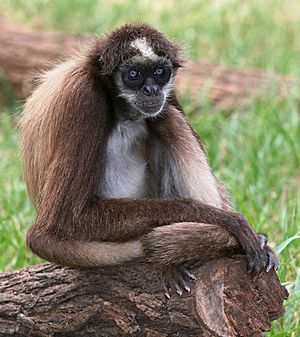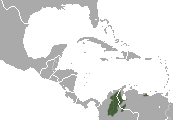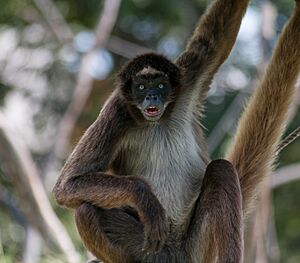Brown spider monkey facts for kids
Quick facts for kids Brown spider monkey |
|
|---|---|
 |
|
| Brown spider monkey at Barquisimeto Zoo, Venezuela | |
| Conservation status | |
| Scientific classification | |
| Genus: |
Ateles
|
| Species: |
hybridus
|
 |
|
| Brown spider monkey range in green | |
The brown spider monkey (Ateles hybridus), also called the variegated spider monkey, is a special type of New World monkey. It lives in the forests of northern Colombia and northwestern Venezuela. Sadly, it is a critically endangered species, meaning it is at high risk of disappearing forever.
Like other spider monkeys, it has long, thin arms and legs. It also has a very long prehensile tail that can grip things like a fifth hand! A unique feature of the brown spider monkey is its whitish belly and a patch on its forehead. Some of these monkeys even have pale blue eyes, which is quite rare for spider monkeys.
Contents
What's in a Name?
Scientists sometimes group animals into smaller categories called subspecies. For a while, some thought there were two types of brown spider monkeys. One was found in Colombia and Venezuela, and another between the Cauca and Magdalena Rivers in Colombia. However, newer studies looking at their DNA suggest they are all part of one single group. So, for now, we think of them as one species.
Appearance and Life Cycle
The brown spider monkey has a unique look. Its arms and legs are long and thin, with its front limbs being longer than its back ones. This helps them move through the trees.
Amazing Tail and Hands
One of its most amazing features is its tail! It can be up to 75 centimeters (about 30 inches) long. This tail is super flexible and strong, acting like a fifth limb to help them grip branches. The tip of the tail has no hair and has special grooves, just like fingerprints, for an even better grip. Brown spider monkeys have four curved fingers but no thumbs. This design is perfect for swinging quickly from branch to branch, a movement called brachiation. They can climb very high and rarely need to touch the ground.
Size and Color
Adult males usually weigh between 7.9 and 9.1 kilograms (about 17 to 20 pounds). Females are a bit lighter, weighing between 7.5 and 9 kilograms (about 16 to 20 pounds). Their body length, not including the tail, is about 35 to 70 centimeters (about 14 to 28 inches). Their fur can be light brown to dark brown, especially on their head and upper body. Many have a clear white triangular patch on their forehead, though not all do. While most have brown eyes, some brown spider monkeys have pale blue eyes, which is very special!
Lifespan
In the wild, these monkeys typically live for about 22 years. Some can live as long as 27 years. In zoos, they can live even longer, sometimes up to 40 years.
Where They Live
Brown spider monkeys call the forests of northern Colombia and northwestern Venezuela home. In Colombia, you can find them near the Magdalena River, in areas like Magdalena and Cesar. They also live in parts of La Guajira and the Serrania de Perija mountains. In Venezuela, they usually live in areas that are 20 to 700 meters (about 65 to 2,300 feet) above sea level.
Habitat Challenges
Sadly, the forests where these monkeys live are shrinking. This is happening because of activities like mining, building new roads, and other industrial projects. This loss of their home makes it harder for their population to grow. Also, brown spider monkeys have a slow reproduction rate, usually having babies only every 2 to 3 years. This means it takes a long time for their numbers to increase.
Their Daily Life and Diet
Brown spider monkeys spend most of their lives high up in the trees. They love forests that haven't been disturbed by humans. Even though they prefer the treetops, they sometimes come down to the ground to eat soil and drink water.
How They Move and Interact
These monkeys travel in small groups. Instead of walking on all fours, they mostly swing and climb between trees. The way they move is very graceful and efficient. The different areas where brown spider monkeys live can affect their social behavior. Sometimes, males and females have strong interactions, which helps them figure out their social order.
What Do They Eat?
Brown spider monkeys are mostly herbivores, meaning they eat plants. They are also frugivores, which means fruit is a big part of their diet. Over three-quarters of what they eat is ripe, fatty fruits. They use their senses of sight, smell, taste, and touch to find food in the forest canopy.
When fruit is harder to find, especially in drier seasons, they will eat other things. This includes leaves, seeds, flowers, tree bark, honey, and even decaying wood. Sometimes, they also eat insects like termites and caterpillars. They enjoy different kinds of figs all year round. Scientists have seen them eating soil and clay. They think the monkeys might do this to get important minerals like phosphorus, or to help balance their pH levels inside their bodies. They find water to drink on the forest floor at special "salado sites." Sometimes, they have to compete with other fruit-eating primates for food.
Who Are Their Predators?
In the wild, brown spider monkeys have natural enemies. These include big cats like jaguars (Panthera onca) and mountain lions (Puma concolor). Large birds of prey, such as harpy eagles (Harpia harpyja) and crested eagles (Morphnus guianensis), also hunt them. When a brown spider monkey senses danger, it might shake branches to try and scare off predators.
Protecting the Brown Spider Monkey
Since 2004, the brown spider monkey has been listed as one of the most endangered primates in Colombia's inter-Andean Valleys.
Why Are They in Danger?
Their population has dropped by at least 80%, and some groups have completely disappeared. This is mainly due to their habitat being broken up into smaller pieces. They are also threatened by hunting, as they are sometimes hunted for food. Another big threat is being captured for the illegal pet trade.
Most of their natural home, about 98%, has already been lost. This habitat loss is caused by logging and clearing land for farms and cattle ranches. Only a few populations are left that are large enough to survive long-term. In 2010, about 60 brown spider monkeys were recorded in zoos, mostly in Europe, but they reproduce slowly.
What's Being Done to Help?
Many groups are working to protect these monkeys. One important effort is creating "corridors." These are safe pathways that connect fragmented parts of their habitat, helping the monkeys move between areas. A recent study in Central Colombia showed that many animal species, including brown spider monkeys, use these corridors.
The IUCN (International Union for Conservation of Nature) is a group dedicated to protecting and growing the spider monkey population. They raise money to help create these connecting corridors. They also work to educate local people who live near the monkeys. This helps raise awareness and encourages more people to help protect them.
A small group of fewer than 30 brown spider monkeys was recently found in a protected area in Colombia, the Selva de Florencia National Natural Park. This is the southernmost known population. Brown spider monkeys are also found in other protected areas in both Colombia and Venezuela. Currently, there are about 3,000 brown spider monkeys left in the forests of Colombia and Venezuela.



